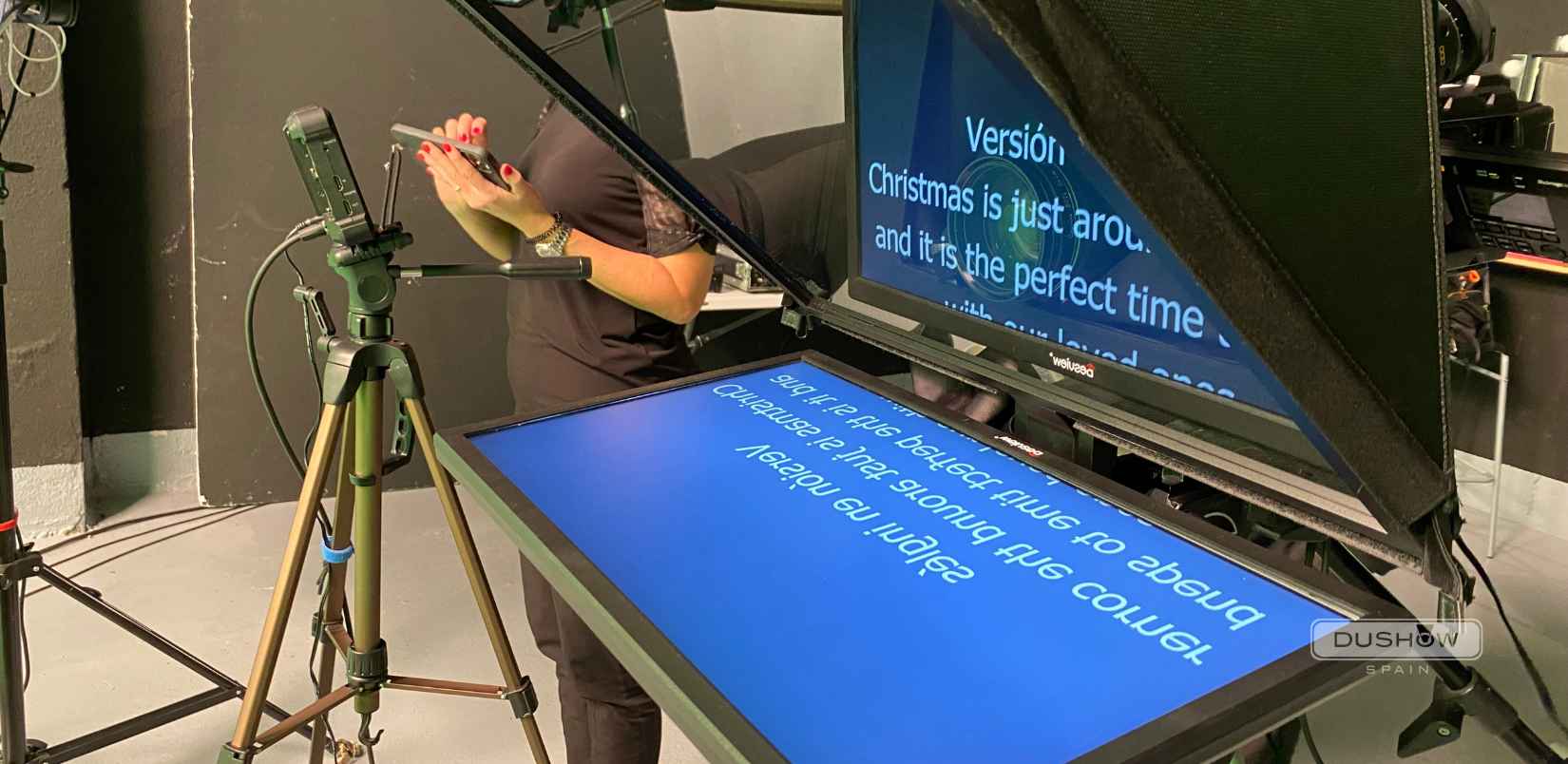Dushow Spain is now Novelty Spain
What is a teleprompter or autocue? 6 tips to optimize their use at your event
A growing number of organizers are considering the use of a teleprompter for the presentations at their events. In fact, if you consider the high competitiveness of the market, plus your own demands and those of attendees to offer an unforgettable experience, you’ll begin to see how good an idea it is to use equipment like this.
If you’re not sure what a teleprompter is or how it works, this article will tell you all you need to know. We’ll also tell you more about their advantages and give some tips on how to get the most from them.
What is a teleprompter?
A teleprompter, also known as an “autocue” is a viewer/screen used as a reading tool, where a previously-drafted text can be shown. It can be affixed to a camera, or placed in front of a speaker to facilitate the verbal delivery of a speech.
It is common to see teleprompters on television shows or newscasts, in addition to other audiovisual formats. They can now be seen at almost any kind of event or when a political speech is given. In all of these cases, their usefulness is similar: the speaker can express and communicate their ideas more easily.
Mechanical paper roll teleprompters were first used in the United States in the 1950’s. Although their hardware and software have evolved, their operation is still very similar to what it was then. A script is projected at a set pace so the presenter or speaker can read it in order.
Advantages of using a teleprompter at your event
Having a teleprompter at your face-to-face or on-line event can give your speakers additional confidence when it’s time to take the stage. Having everything you need to say front and centre can give you peace of mind and put stage fright to rest. What are the advantages of having a teleprompter?
- Thanks to today’s teleprompters, speakers can look at the audience and read the script simultaneously.
- There is no need to learn the entire speech by heart, or have notes that force the speaker’s gaze away from the audience. Even so, it is a good idea to have cue cards in case anything goes wrong with the teleprompter.
- Having the complete text, mistakes and slips of memory all diminish significantly. You can convey your message clearly.
- It all improves the speaker’s non-verbal language and strengthens the feeling of the speech.
- By preparing the text in advance, you can make sure it has the right tone, intonation and pace.
- Even though you’re reading from a screen, there is still room for improvisation.
- Teleprompters are invisible to the audience. They do not undermine their experience. Quite the opposite is true.
6 tips on using a teleprompter at an event
As you can see, using a teleprompter at your events is a magnificent idea. They’re affordable to rent and bring many advantages. Have you decided to use one soon? Here are a few tips that can turn out to be useful.
Studying the script is key
It is true that a teleprompter saves you the tedious task of memorizing your speech. But you shouldn’t trust everything to a single device. You should first study your script, and read through it several times, to have your ideas clear when it’s time to stand and deliver.
Use the right language
Using the right language is crucial when it comes to writing the script for a teleprompter. When writing your script, always remember that the text will be read out loud. The simplest way is to write it as you speak. If not, the result may sound stilted.
Is the text clear?
For a teleprompter to be useful, the text displayed must be clear and consistent. You should use texts that are free from incongruencies, unnecessary information or excessive complication. Simplicity and objectivity will make the script much easier to deliver when you are speaking into a microphone in front of a full room. If another speaker is addressing the audience, help them by going over all of this before they take the floor.
Use the right font size
Remember that the teleprompter’s size is limited. So it’s not recommended to use a font that is too large. If you do, it will limit the volume of content that can be seen on the screen. Using a medium-size or small font will enable you to strike a balance between visual comfort and a fluid intonation and pace of your speech.
Rehearse
Though they are becoming more common, most people have limited or no experience with teleprompters. In such cases, the best solution is to rehearse a little before shooting or holding a live event. This helps work out any uncertainty there mspeeay be with the audiovisual company you’ve hired. Although it’s easy to get used to it, spending a few minutes on a trial run will be good for the one giving the speech as well as the attendees.
If you’d like to learn more about how to choose the right audiovisual partner to organize and produce your next event, this video covers seven key aspects to bear in mind when choosing the right company, and the benefits of hiring one.
Hire a teleprompter operator
Hiring someone to run the teleprompter can be a great idea. These professionals are completely familiar with these devices and the inner workings of such audiovisual scenarios. Having a professional from the industry will not only help you more easily overcome the technical problems that can arise, but also improve the overall user experience.
We hope you’ve found this article useful. As shown, using a teleprompter during an event or conference can be a great aid to speakers. While they benefit from more peace of mind and confidence when delivering their speech, attendees can enjoy a higher-quality event.
Please make sure to subscribe to our channel and visit our blog to never miss out on any essential content on the technical production and organization of face-to-face, hybrid and virtual events.
This article was first published in Dushow Spain, you can read the original Spanish version here.





